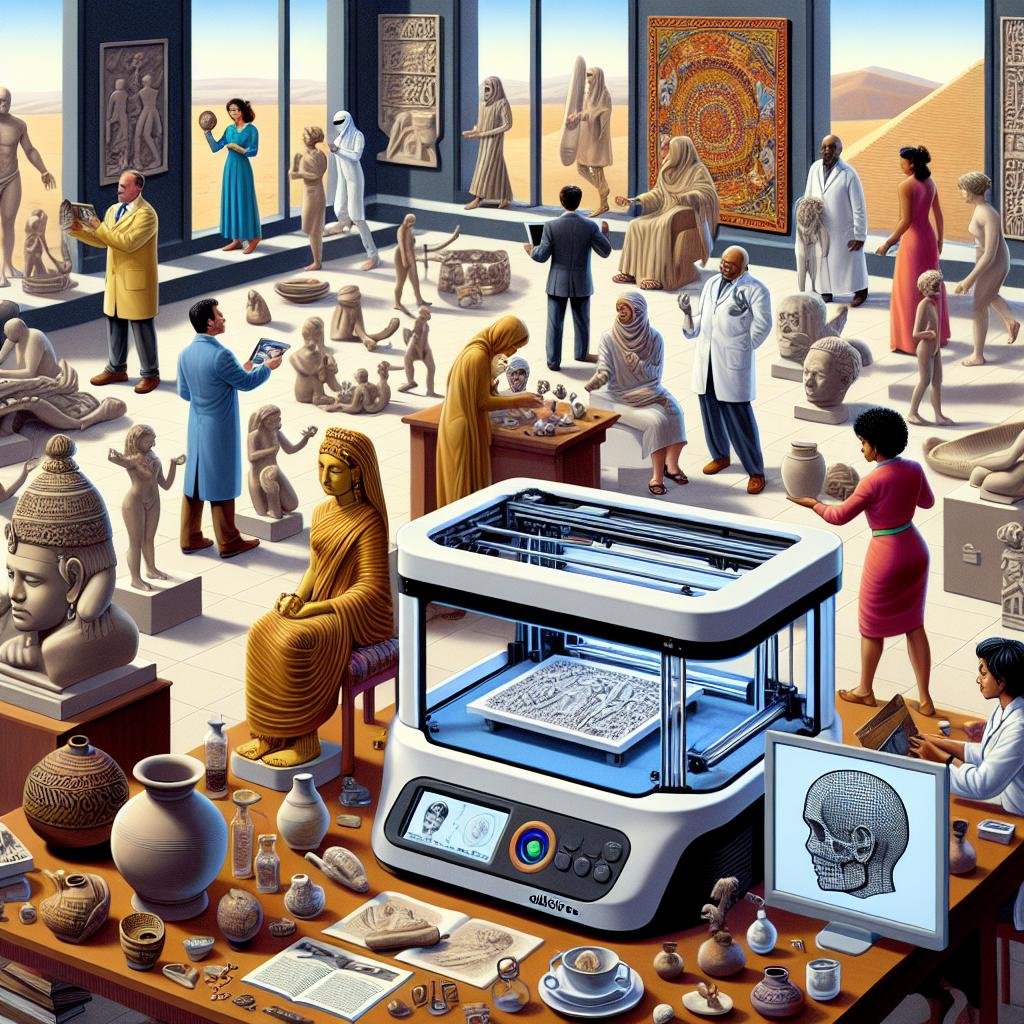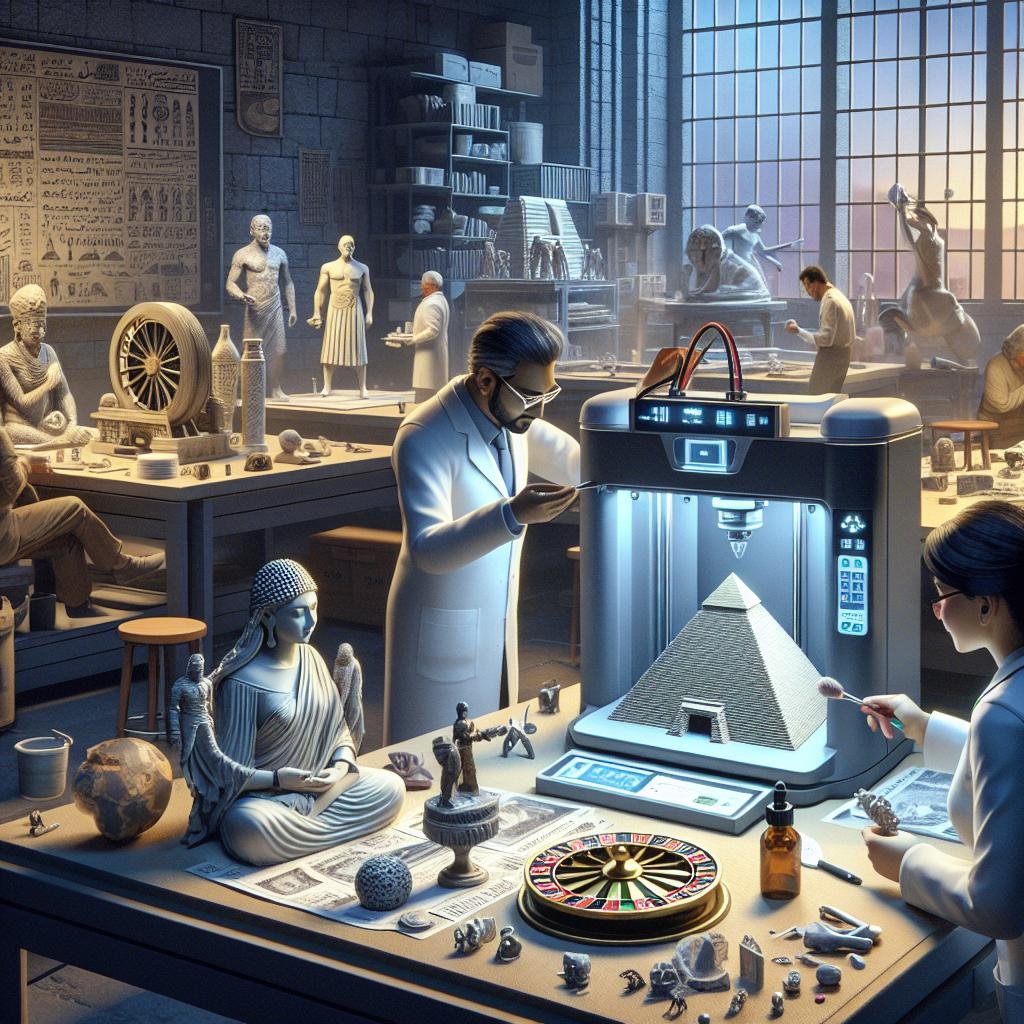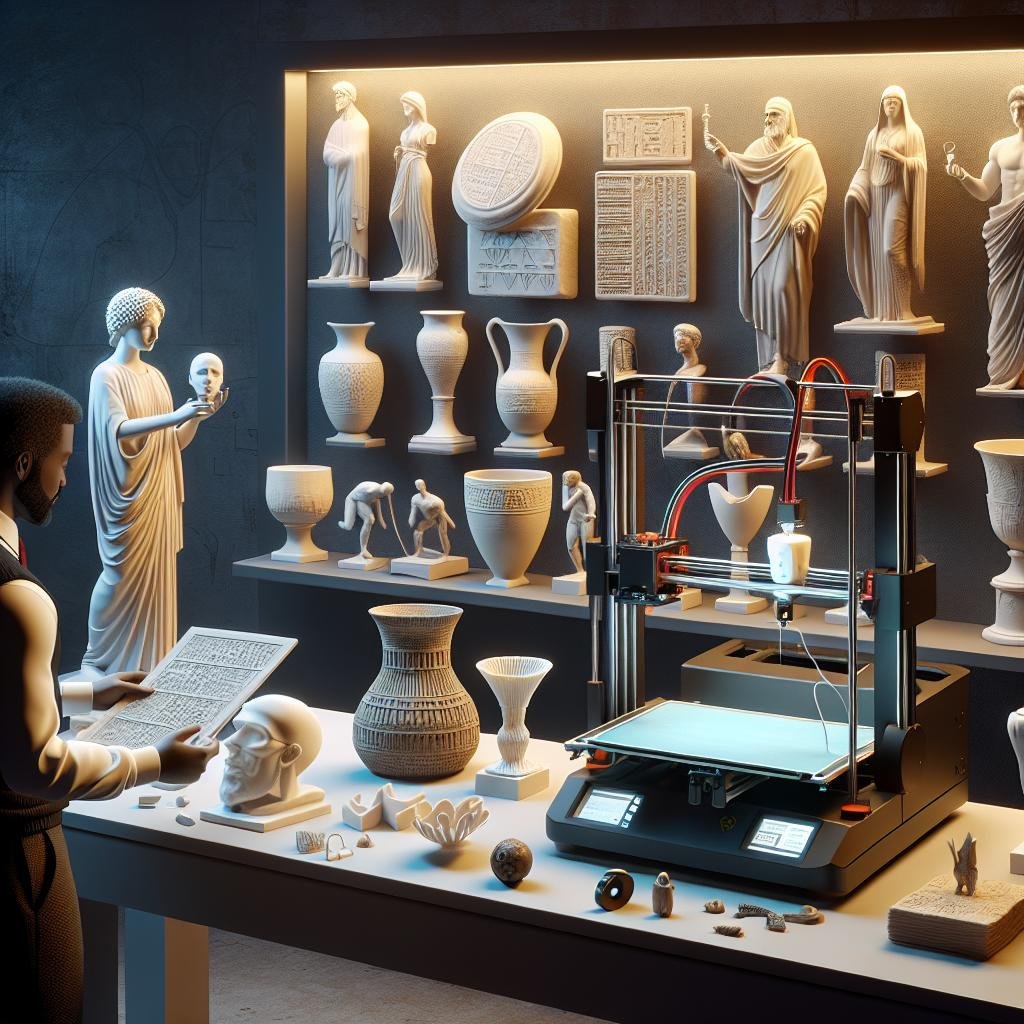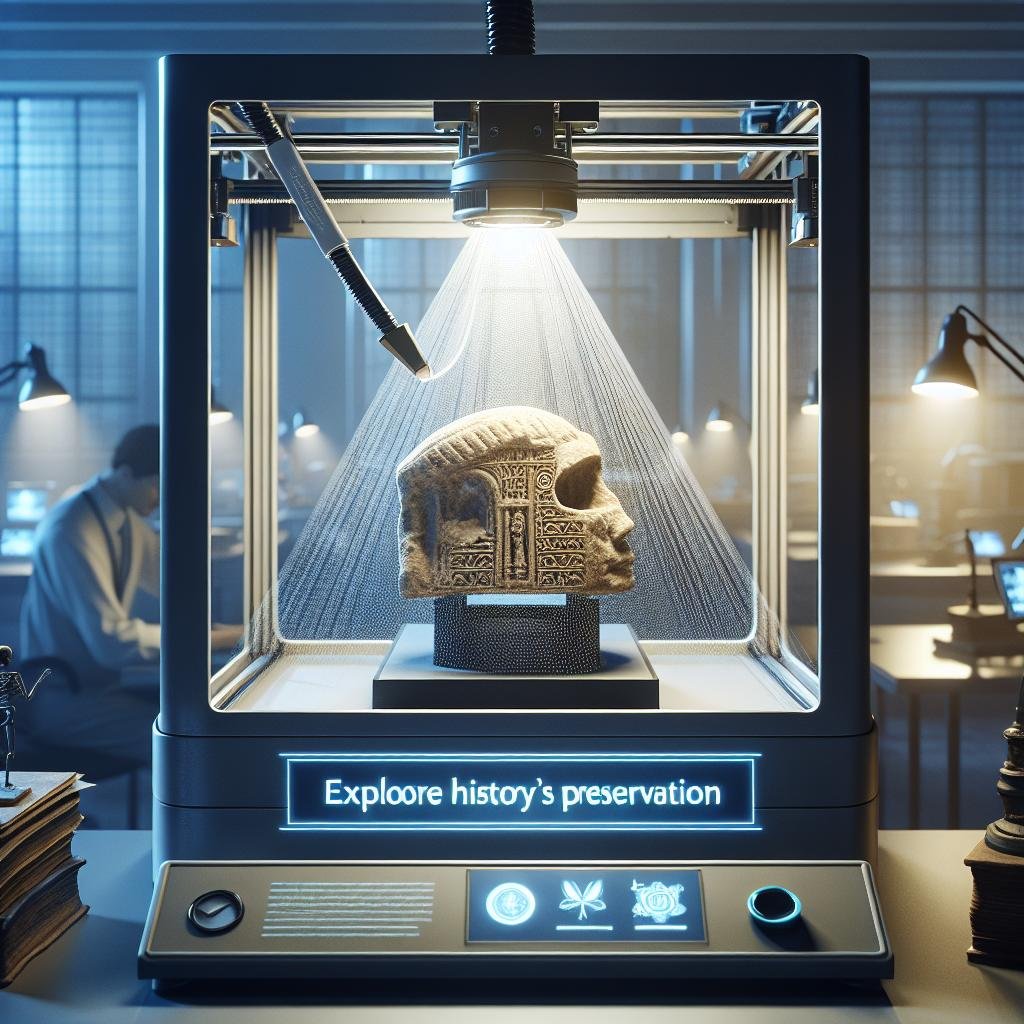Imagine the ancient pyramids of Egypt standing tall against the desert’s endless horizon, or the delicate, intricate craftsmanship of a 500-year-old Italian sculpture. These wonders of human achievement connect us to our shared past, telling stories of ingenuity, artistry, and culture. Now, envision a world where these treasures, and countless others, could be perfectly replicated and preserved, accessible to anyone, anywhere, at any time. Welcome to the revolutionary nexus of 3D printing and cultural heritage — where the marvels of yesterday meet the technology of tomorrow. Join us on this fascinating journey as we explore how 3D printing is not just a tool, but a time machine, breathing new life into the relics of history and ensuring their legacy endures for generations to come.
Embracing the Tangible: 3D Printing as a Cultural Time Machine
Imagine holding a piece of history in your hands, intricately recreated with the precision of modern technology. This is no longer a mere flight of fancy but a growing reality, thanks to 3D printing. Cultural artifacts, from ancient pottery to timeless sculptures, can now be replicated with stunning accuracy, providing an intimate connection to our shared heritage. With 3D printing, schools, museums, and historical sites are able to offer more tangible and engaging educational experiences. Students can physically interact with history-class relics, fostering a deeper appreciation for the stories they tell.
Moreover, this technology bridges the gap between inaccessible or fragile artifacts and the public. Instead of a ‘Do Not Touch’ sign, visitors can engage with exact replicas, bringing cultural appreciation to a more inclusive level. This democratization of history also preserves vulnerable objects, allowing us to study, display, and enjoy historical treasures without risking their integrity.
| Artifact Type | Replica Benefit |
|---|---|
| Ancient Vases | Hands-on Learning |
| Historical Sculptures | Inclusive Engagement |
| Delicate Manuscripts | Conservation |

Breathing Life into Artifacts: Techniques for Accurate Replication
Harnessing the power of cutting-edge technologies, 3D printing has emerged as an indispensable tool in the realm of cultural heritage. The process entails the meticulous capturing of an artifact’s dimensions, textures, and intricate designs using high-resolution scanners. These captured details are then converted into a digital model, which serves as the blueprint for the 3D printer. The printer uses a variety of materials—ranging from plastics to more specialized resins and metals—to recreate the original artifact with stunning precision. By leveraging these advanced techniques, museums and preservationists are afforded the opportunity to create exact replicas that not only safeguard the object’s legacy but also make it more accessible to the public.
However, achieving high-fidelity replication involves several key steps and considerations:
- Material Selection: Choosing the right material that mimics the original artifact’s properties.
- Scaling: Ensuring the replica matches the original in scale and proportion.
- Detail Accuracy: Utilizing high-resolution scanners to capture even the smallest features.
- Post-Processing: Applying finishing touches to achieve a vivid resemblance.
| Technique | Material |
|---|---|
| High-Resolution Scanning | Laser Scanners, Photogrammetry |
| 3D Printing | PLA, ABS, Resin |
| Finishing | Painting, Sanding |

Digital Custodians: The Role of Technology in Conservation
In today’s world, 3D printing has ushered in a new era of possibilities for cultural preservation, creating precise replicas of ancient artifacts and monuments. This technology allows conservationists to digitally scan and produce physical models with incredible accuracy. Imagine holding a flawless reproduction of an ancient Greek vase—you can see, touch, and even study it without risking the original. Moreover, these replicas serve educational purposes, providing tactile experiences for students and enthusiasts alike. Such initiatives foster deeper connections between communities and their heritage, promoting awareness and appreciation.
Apart from creating replicas, 3D printing aids in the restoration of damaged artifacts. Using 3D scans, restoration experts can produce missing fragments of ancient sculptures, making it possible to restore them to their former glory. The flexibility and precision of 3D printing technology have revolutionized how we approach restoration projects. Below is a table highlighting some key benefits of using 3D printing in cultural heritage conservation:
| Benefit | Description |
|---|---|
| Accuracy | High precision in recreating details. |
| Accessibility | Makes cultural artifacts available globally. |
| Restoration | Restores missing parts with exact detail. |
| Education | Provides hands-on learning experiences. |

Future-Proofing History: Best Practices for Sustainable Cultural Preservation
Cultural heritage sites and artifacts tell the intricate stories of our past, but they are increasingly vulnerable to natural disasters, environmental changes, and human activities. Enter 3D printing technology to the rescue! By creating highly detailed replicas of artifacts and even entire archaeological sites, we can preserve these treasures digitally and physically. Imagine walking through an ancient ruin or admiring a priceless artifact that was once out of reach. With 3D printing, museums can offer interactive experiences while safeguarding the original pieces. The magic lies in blending the old with the new, protecting history while making it more accessible.
Implementing 3D printing in cultural preservation involves a few best practices:
- High-Resolution Scanning: Ensuring that every detail is captured accurately.
- Material Selection: Choosing sustainable and durable materials for printing.
- Collaboration: Involving historians, archaeologists, and technologists in the process.
| Practice | Benefit |
|---|---|
| High-Resolution Scanning | Preserves intricate details |
| Material Selection | Ensures long-term durability |
| Collaboration | Combines expertise for better results |
Q&A
Q: What is the connection between 3D printing and cultural heritage preservation?
A: Imagine being able to hold a piece of history in your hands! 3D printing is like magic for cultural heritage preservation. It allows us to create detailed and accurate replicas of ancient artifacts, monuments, and historical sites. These replicas can be used for research, education, and even to help restore damaged originals. Essentially, 3D printing bridges the past and the future, giving tangible form to history’s most cherished treasures.
Q: How does 3D printing help in safeguarding artifacts that are fragile or deteriorating?
A: You know how some things get more delicate with age? Artifacts are no different. That’s where 3D printing steps in like a superhero! It enables us to make exact copies of fragile or deteriorating artifacts without touching or further damaging the originals. These replicas can stand in for the originals in exhibitions and educational settings, reducing the handling and stress on the historic pieces themselves. It’s like creating an immortal clone that can withstand the hands of time.
Q: Can 3D printing help in restoring damaged historical artifacts and sites?
A: Absolutely! Think of 3D printing as the perfect puzzle-master. When historical artifacts or sites get damaged, 3D printing can create the missing pieces with incredible precision. Using digital scans and data, restorers can print out parts that fit exactly into the damaged areas, making restoration more accurate and reversible. It’s like getting a custom-made piece for your favorite jigsaw puzzle!
Q: Is 3D printing accessible to museums and cultural institutions around the world?
A: More than you might think! While high-end 3D printing equipment can be pricey, there are a range of options available. Many museums, universities, and cultural institutions are beginning to adopt 3D printing technology. Plus, as technology advances, it’s becoming more affordable and accessible. Just like the first computers, what once seemed like futuristic tech is becoming part of our everyday toolkit for preserving history.
Q: How can 3D replicas be used in education and public engagement?
A: Imagine going to a museum and not just seeing, but touching a replica of an ancient statue or a medieval sword! 3D replicas can be used hands-on in classrooms and museums to give students and visitors a more interactive and engaging experience. These replicas also make it possible to share rare or delicate artifacts with a wider audience without risking damage. It’s a fantastic way to bring history to life and make learning more immersive and fun.
Q: What about the ethical considerations of replicating cultural artifacts?
A: Great question! It’s essential to approach 3D printing of cultural artifacts with respect and sensitivity. This tech should be used in collaboration with cultural groups and custodians of heritage to ensure that replicas honor the original context and significance of the artifacts. Transparency, permission, and proper attribution are key. It’s all about using new technology to enhance, rather than exploit, our rich and diverse heritage.
Q: What’s the future of 3D printing in cultural heritage preservation looking like?
A: Bright and exciting! We’re just scratching the surface of what 3D printing can do. As technology continues to evolve, it will bring new possibilities for precision, materials, and applications. From creating more interactive museum exhibits to enabling virtual global tours of historical sites, 3D printing is set to revolutionize how we preserve and experience cultural heritage. It’s a future where the past is not only remembered but vividly relived.
The Way Forward
As we stand on the cusp of a technological renaissance, 3D printing emerges not just as a tool, but as a time machine that bridges eras, reviving relics from antiquity and gifting them anew to the future. This dance of pixels and polymers doesn’t merely replicate history; it resurrects stories long buried beneath the sands of time.
Imagine a future where a student in Tokyo can explore the contours of a Greek amphora, or a local artisan in Peru can recreate the intricate weavings of Incan textiles with newfound precision. This is not mere fantasy, but the tangible promise of 3D printing—a promise that is unfolding even as you read these words.
In this grand endeavor to preserve our collective heritage, every print, every scan, and every digital layer connects us in an intricate tapestry of shared human experience. We are the custodians of this legacy, weaving a bridge to the past even as we carve pathways to the future. Let us step forward with reverence and curiosity, for the echoes of history are calling, and with our new tools, we can answer them like never before.
Together, we are not just preserving artifacts. We are saving the soul of our civilization, ensuring that the stories of yesteryears will continue to inspire and educate for generations to come.
So, the next time you see the quiet hum of a 3D printer, remember: it’s the sound of history coming back to life.
Until then, keep exploring, keep preserving, and keep printing the tales of humanity.
Safe journeys on your historical adventures!

